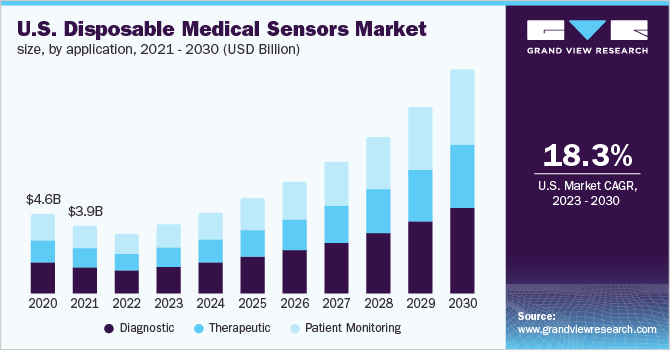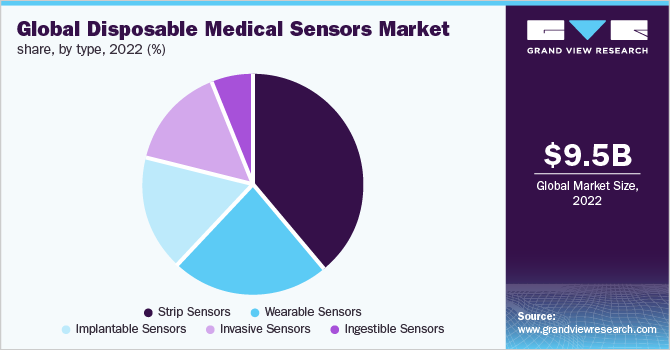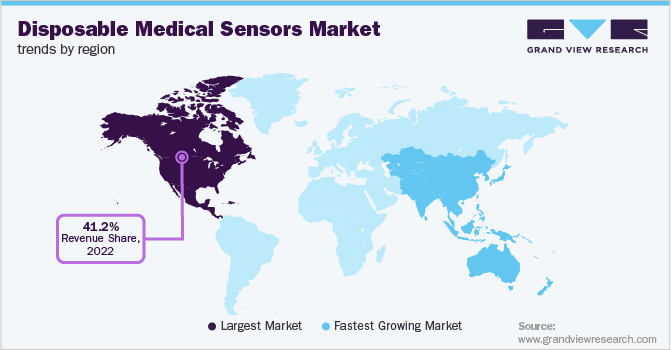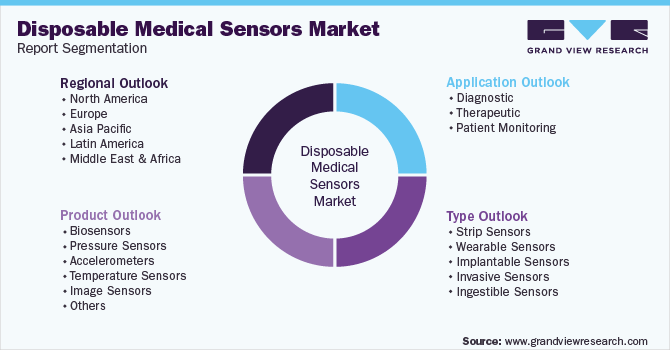- Home
- »
- Medical Devices
- »
-
Disposable Medical Sensors Market Size & Share Report, 2030GVR Report cover
![Disposable Medical Sensors Market Size, Share & Trends Report]()
Disposable Medical Sensors Market Size, Share & Trends Analysis Report By Application (Diagnostic, Therapeutic, Patient Monitoring), By Product (Biosensors, Pressure Sensors), By Type, By Region, And Segment Forecasts, 2023 - 2030
- Report ID: 978-1-68038-256-3
- Number of Report Pages: 110
- Format: PDF, Horizon Databook
- Historical Range: 2018 - 2021
- Forecast Period: 2023 - 2030
- Industry: Healthcare
Report Overview
The global disposable medical sensors market size was valued at USD 9.52 billion in 2022. It is expected to grow at a compound annual growth rate (CAGR) of 18.45% from 2023 to 2030. The growth of the disposable medical sensors industry is attributed to technological advancements, increasing demand for health data tracking, and demand for low-cost medical devices. The increasing prevalence of chronic diseases across the globe is likely to boost the demand for disposable medical sensors. for instance, According to Front. Public Health in 2020, chronic non-communicable diseases (NCDs) accounted for about 80% of mortality in China among adults aged 60, with Ischemic heart disease, stroke, Chronic Obstructive Pulmonary Disease (COPD), and Type 2 diabetes being the most common.

The cost of health care continues to rise each year. The factors leading to this rise are; the increasing demand for diagnostic devices, additional taxes on devices in certain regions, and increased regulations which in turn impact the overall cost of production. The increased healthcare expenditure becomes a burden for middle-income countries. This has over time, led to the demand for low medical devices, the development of which is of primary importance to all healthcare industry players. The development of low-cost medical devices with technological advancement in medical sensors would help middle-income and low-income countries gain access to diagnostic devices. Government initiatives to reduce healthcare costs are expected to benefit the market.
The pandemic also revealed the weakness of the global healthcare system. It highlighted the urgent need for technology and solutions to assist clinicians in managing dangerously ill patients. Patients with COVID-19, severe illnesses including cancer and heart disease, a backlog in non-urgent treatment, an aging population, and struggles with burnout and a labor shortage. Manufacturers responded by introducing services and products that aid healthcare systems in improving efficiency and productivity, decreasing clinician burnout, supplying clinicians with analytics and AI when and where they need it, building a more resilient and sustainable healthcare sector, and expanding access to care. These remain key drivers to the growth of the disposable medical sensors market.
For instance, in April 2020, to assist physicians and healthcare organizations in the care of COVID-19 patients, GE Healthcare unveiled a new software solution. The business will be introducing its Virtual Care Mural Solution, which is intended to give hospitals a thorough understanding of their ventilated patient population and assist in the identification of patients in danger of deterioration, to the highly reputable and secure Microsoft Azure cloud platform. This represents the most recent development in Microsoft and GE Healthcare's continuous partnership.
Moreover, in May 2020, Philips introduces the next-generation wearable biosensor for clinical COVID-19 surveillance and early patient deterioration identification. The small, disposable biosensor is a five-day wearable patch that may be linked with a scalable hub to monitor numerous patients in various rooms.
A study about the transmission of coronavirus with skilled nursing facilities stated that the asymptomatic rate of transmission was 56%, of which 90 % shows symptoms subsequently. From this, it can be concluded that the symptom-based screening technique may fail to detect over 50% of people affected by a coronavirus. The continuous data monitoring generated by disposable medical sensors can overcome these challenges.
Wearable technology to assist patients infected with the novel coronavirus (COVID-19) is expected to boost market growth. For instance, the DETECT research, which stands for Digital Engagement & Tracking for Early Control & Treatment, was launched by the Scripps Research Translational Institute., which uses devices such as Apple Watch, Fitbit, and Garmin for tracing sleep data & heart-rate activity and corresponds them with symptom reports submitted by patients to track COVID-19 cases. According to a recent study, Fitbits can predict COVID-19 symptoms in 78% of patients.
The trend toward portability and care delivery at the patient's bedside or home is pushing the construction of next-generation therapeutic, diagnostic, display, and monitoring equipment that is more accurate, adaptable, and small. These platforms have a consumer-driven approach to healthcare that incorporates technological advancements like personalized wearables, electronic patient records, and wireless internet-linked systems, all of which are expected to provide intelligent, convenient, and at-home healthcare.
The main reason behind the trend of portable disposable medical sensors devices at home is the rapidly aging population, which is chronically ill and disabled. Hence, this is likely to encourage manufacturers to develop medical devices that patients can carry unobtrusively even in public spaces. For instance, in July 2020, to improve remote patient monitoring for patients at risk, BioIntelliSense and Philips forged a strategic partnership. This will make it easier for doctors to keep an eye on patients who are being treated in hospitals at home. Philips will be able to better monitor patient populations who have persistent disabilities because of this.
Technological advancements such as cancer tracking sensor, Micro-Electro-Mechanical Systems (MEMS) sensor technology, and fiber optic technology is expected to drive the market. Rising demand for new products with changing lifestyles need for ease and better facilities are leading to innovations. Technological advancement has led to improvement in business by increasing productivity, simplifying the use of the device, and making it convenient for patients to improve their health.
Innovations in medical sensors have not only made them convenient but also made the device portable and automated. For instance, in June 2021 the first 8-megapixel (MP) resolution sensors for reusable and single-use endoscopes were recently unveiled by OMNIVISION Technologies, Inc. Additionally, OMNIVISION gives the medical industry ground-breaking imaging capabilities outside of the visible spectrum, is used for the first time in a medical-grade image sensor, the new OH08B, which boosts sales.
Application Insights
The diagnostic led the market and accounted for more than 39.38% share of the global revenue in 2022. Disposable medical sensors are used in a variety of diagnostic devices such as surgical tools, endoscopy, spirometry, and medical imaging devices. With the sensors, the diagnostic devices are enhanced and the disease is detected at an early stage. For instance, carbon nanotube-based biosensors are used for the detection of microorganisms such as S. aureus and E. coli. The technological advancement in the sensors such as high speed and low cost is enabling faster and more accurate results. Additionally, wireless communications along with integrated biosensors are creating growth opportunities in the diagnostic field.
Moreover, the increasing prevalence of chronic diseases and the demand for diagnostics. Chronic diseases, such as diabetes, need diagnostic to check the person's symptoms and signs of the disease in patients. Thus, several devices designed to track activities as well as monitor the risks associated with the health of patients are available. For instance, in October 2020, together, STMicroelectronics and Alifax S.r.l., a manufacturer of clinical diagnostic equipment, developed an affordable and quick portable solution to amplify genetic material (DNA1 and RNA) in patient samples for point-of-care molecular diagnostic detection using highly reliable Polymerase Chain Reactions (PCR) real-time. This solution will be made available by Alifax.
The patient monitoring segment is expected to expand at the highest CAGR during the forecast period. Medical sensors are used in patient monitoring devices such as pulse oximetry, blood pressure monitors, and others. With the advancing technology and increasing need for better monitoring devices, the need for medical sensors is rising. Additionally, new product launches are enhancing the quality of care. For instance, Philips is expected to launch a next-generation monitoring biosensor that would continuously and automatically measure vital signs such as skin temperature, heart rate, and respiratory rate.
Moreover, due to the various advantages of these sensors, the demand for these devices is anticipated to increase during the forecast period. Increasing R&D investment, and collaboration between companies are also expected to propel market growth. For instance, in March 2022, recently, Rockley Photonics Holdings Limited announced that it would work with Medtronic on future projects. The two businesses want to work together to implement Medtronic's solutions and Rockley's recently released Bioptx biomarker sensing technology in a range of healthcare settings. The collaboration with Medtronic expands on the social change from reactive to proactive healthcare by potentially delivering real-time, round-the-clock, non-invasive monitoring of a person's well-being and health, allowing doctors to customize care using actionable data which is expected to spur the segment growth in the near future.
Product Insights
In 2022, the biosensors segment dominated the market with a share of over 49.70%. A biosensor is a sensor that is used for detecting the analyte. It collects biological components through a physiochemical detector. The signals obtained from the analyte are detected and measured. The biosensors are usually associated with the electronics, the signals are received by the sensor and are displayed on the device.
There are various types of biosensors used such as electronic, amperometric, blood glucose, potentiometric, conduct metric biosensors, thermometric, optical, fiber optic lactate, immune, and piezoelectric biosensors. Biosensors find application in patient monitoring as well as diagnostics. The rising demand for rapid and accurate diagnostic kits is creating opportunities for the growth of biosensors. Furthermore, owing to innovation, the requirement to perform faster diagnosis is expected to promote the development of advanced biosensors over the forecast period.
The image sensors segment is expected to expand at the highest CAGR during the forecast period. Image sensors utilize light waves and convert them into signals to form an image and find high applicability in the diagnostic segment. Image sensors are used in medical imaging devices such as endoscopy, and electronic imaging devices such These sensors are of two types, charge-coupled devices (CCD) and complementary metal oxide semiconductors (CMOS).
The CMOS image sensors are more commonly used than CCD owing to the lesser power consumption and faster speed of diagnosis. CMOS are mainly used in x-ray imaging, minimally invasive surgery, endoscopy, and ocular surgery. The technological advancements and the need for higher resolution are expected to fuel the market growth over the forecast period.
Type Insights
In 2022, the strip sensors segment dominated the market with a share of over 38.76%. Strip sensors are mainly used in blood glucose monitoring, disease testing, and magnetic nanoparticles. The strip sensors segment holds the largest market share owing to the increasing demand and its usage in diagnostic applications. An additional benefit of using strip sensors is that the results are obtained faster. Moreover, the demand for self-diagnosis and home-based medical devices is fueling the market.
The ingestible sensors segment is expected to expand at the highest CAGR during the forecast period. An ingestible sensor is a small chip that is swallowed in the form of a capsule, the chip detects the body abnormalities if any and transmits the data to the device outside. These sensors are mainly used in endoscopy, controlled drug delivery, and patient monitoring. The increasing prevalence of chronic diseases and the need for invasive diagnostic testing is propelling the growth of ingestible sensors. Additionally, the results obtained by using ingestible sensors are more accurate which is expected to fuel the market further.

Due to the various advantages of ingestible sensors, the demand for these devices is anticipated to increase during the forecast period. Increasing R&D investments and collaborations between companies are also expected to propel market growth. In July 2021, according to Medtronic plc, the FDA cleared the use of two LINQ II insertable cardiac monitors with the AI AccuRhythm algorithms. When the AI AccuRhythm algorithms are made accessible on the CareLink Network later this year, all LINQ II implants in the U.S will be able to use them.
Regional Insights
North America dominated the market with the largest revenue share of over 41.18% in 2022. This is due to factors including its established healthcare infrastructure, high healthcare spending, the existence of monopolistic market players, and the quick uptake of cutting-edge technologies.
The global disposable medical sensors industry is most developed in North America. Over the projection period, the market is expected to be driven by the rapid uptake of patient monitoring and homecare devices for routine, ongoing, and long-term patient monitoring and lowering the frequency of hospital visits.

Favorable reimbursement policies are anticipated to further fuel market expansion in North America. The rising prevalence of lifestyle-related health issues, accidents, and sports injuries are further reasons that are projected to fuel market growth in North America. The increasing use of mobile surgery centers and rising demand for effective emergency care are anticipated to boost the market during the forecast period.
Furthermore, disposable medical sensors are becoming more necessary due to the COVID-19 pandemic, since people chose to receive care at home rather than risk getting sick. In the U.S, 23.4 million patients used remote patient monitoring (RPM) tools and services in 2020, and 30 million patients—or 11.2% of the population—will do so by 2024, according to a survey by Insider Intelligence. To improve patient monitoring and treatment options, as well as to lessen healthcare workers' exposure to SARS-CoV-2 during the pandemic, the FDA granted Emergency Use Authorizations (EUAs) for a number of wearable and patient monitoring devices.
The Asia-Pacific is expected to register the fastest growth in the global disposable medical sensors market during the forecast period. In APAC nations, there is a demand for disposable medical sensor equipment due to the increased prevalence of cardiac disorders. Additionally, China and India have the highest prevalence of diabetes in the globe, making them the most affected nations. In 2021, 90 million people (20-79) will have diabetes in the South-East Asia (SEA) Region of the International Diabetes Federation (IDF), according to one prediction. This figure is expected to increase to 113 million and 152 million people, respectively, by 2030 and 2045.
According to the Indian Journal of Ophthalmology, globally and in emerging nations like India, the burden of diabetes is large and rising, primarily due to rising rates of overweight/obesity and unhealthy lifestyles. In India, 77 Mn people were estimated to have diabetes in 2019, and by 2045, that number is projected to reach over 134 million. As a result, the region is seeing an increase in demand for home-based disposable medical sensors, which is opening up new market opportunities. Furthermore, the area is home to several major companies in the global market for disposable medical sensors, which helps to boost its market share.
Key Companies & Market Share Insights
Manufacturers of disposable medical sensors are working more quickly to obtain licenses for their products so that mass production may start. Additionally, the market participants are utilizing a variety of tactics, including partnerships, product launches, product releases, and innovations like the development of disposable medical sensors products, to improve their position in the market.
For instance, in February 2021, Hill-Rom disclosed that it had paid EarlySense USD 30 million for its contactless continuous monitoring technology. With a focus on the remote patient care industry, this acquisition can assist the company in developing next-generation AI-based sensing technologies. Moreover, in May 2021, Stryker acquired OrthoSesnsor, Inc. This was expected to help the company gain market share in musculoskeletal care & sensor technology for joint replacement. Some prominent players in the global disposable medical sensors market include:
-
SSI Electronics
-
ACE Medical Devices
-
Sensirion AG Switzerland
-
Smith’s Medical
-
Koninklijke Philips N.V.
-
GE Healthcare
-
Analog Devices, Inc.
-
Honeywell International Inc
-
TE Connectivity
-
Medtronic
-
NXP Semiconductor
Disposable Medical Sensors Market Report Scope
Report Attribute
Details
Market size value in 2023
USD 11.08 billion
Revenue forecast in 2030
USD 36.24 billion
Growth Rate
CAGR of 18.45% from 2023 to 2030
Base year for estimation
2022
Historical data
2018 - 2021
Forecast period
2023 - 2030
Quantitative units
Revenue in USD million and CAGR from 2023 to 2030
Report coverage
Revenue forecast, company ranking, competitive landscape, growth factors, and trends
Segments covered
Application, type, product, region
Regional scope
North America; Europe; Asia Pacific; Latin America; MEA
Country scope
U.S.; Canada; U.K.; Germany; France; Italy; Spain; Japan; China; India; Australia; South Korea;Brazil; Mexico; Colombia; Argentina; South Africa; Saudi Arabia; UAE
Key companies profiled
SSI Electronics; ACE Medical Devices; Sensirion AG Switzerland; Smiths Medical; Koninklijke Philips N.V.; GE Healthcare; Analog Devices Inc.; Honeywell International Inc, TE Connectivity; Medtronic; NXP Semiconductor
Customization scope
Free report customization (equivalent up to 8 analysts working days) with purchase. Addition or alteration to country, regional & segment scope
Pricing and purchase options
Avail customized purchase options to meet your exact research needs. Explore purchase options
Global Disposable Medical Sensors Market Segmentation
This report forecasts revenue growth at the global, regional, and country levels and provides an analysis of the latest industry trends in each of the sub-segments from 2018 to 2030. For this study, Grand View Research has segmented the global disposable medical sensors market report based on application, product, type, and region:

-
Application Outlook (Revenue, USD Million, 2018 - 2030)
-
Diagnostic
-
Therapeutic
-
Patient Monitoring
-
-
Product Outlook (Revenue, USD Million, 2018 - 2030)
-
Biosensors
-
Pressure Sensors
-
Accelerometers
-
Temperature Sensors
-
Image Sensors
-
Others
-
-
Type Outlook (Revenue, USD Million, 2018 - 2030)
-
Strip Sensors
-
Wearable Sensors
-
Implantable Sensors
-
Invasive Sensors
-
Ingestible Sensors
-
-
Regional Outlook (Revenue, USD Million, 2018 - 2030)
-
North America
-
U.S.
-
Canada
-
-
Europe
-
U.K.
-
Germany
-
France
-
Italy
-
Spain
-
-
Asia Pacific
-
Japan
-
China
-
India
-
Australia
-
South Korea
-
-
Latin America
-
Brazil
-
Mexico
-
Argentina
-
Colombia
-
-
Middle East and Africa (MEA)
-
South Africa
-
Saudi Arabia
-
UAE
-
-
Frequently Asked Questions About This Report
b. The global disposable medical sensors market size was estimated at USD 9.52 billion in 2022 and is expected to reach USD 11,080.26 million in 2023.
b. The global disposable medical sensors market is expected to grow at a compound annual growth rate of 18.45% from 2023 to 2030 to reach USD 36.24 billion by 2030.
b. North America dominated the disposable medical sensors market with a share of 41.18% in 2022. This is attributable to rising increasing prevalence of healthcare-associated infections, the need for cost-effective medical diagnostics, and the rising demand for home diagnosis.
b. Some key players operating in the disposable medical sensors market include Medtronic, TE Connectivity, Sensirion AG, Smiths Medical, Philips Healthcare, Analog Devices, NXP Semiconductors, GE Healthcare, STMicroelectronics, and OmniVision Technologies.
b. Key factors that are driving the market growth include demand for low-cost medical devices, government initiatives to encourage R&D, and technological advancement
Share this report with your colleague or friend.
![gvr icn]()
NEED A CUSTOM REPORT?
We can customize every report - free of charge - including purchasing stand-alone sections or country-level reports, as well as offer affordable discounts for start-ups & universities. Contact us now
![Certified Icon]()
We are GDPR and CCPA compliant! Your transaction & personal information is safe and secure. For more details, please read our privacy policy.
We are committed towards customer satisfaction, and quality service.
"The quality of research they have done for us has been excellent."





